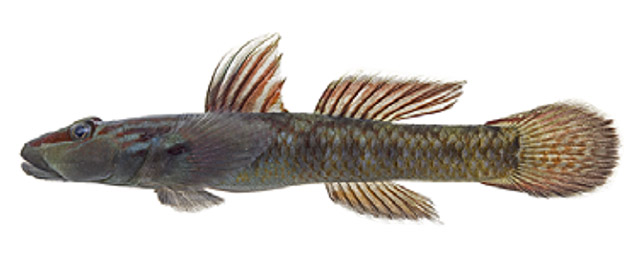| Gobiidae (Gobies), subfamily: Gobionellinae |
| 7.52 cm SL (male/unsexed); 6.02 cm SL (female) |
|
demersal; freshwater, amphidromous |
| Asia: Japan, Ryukyu Is. |
|
Dorsal spines (total): 7-7; Dorsal soft rays (total): 8-8; Anal spines: 1-1; Anal soft rays: 8-8; Vertebrae: 26-26. This species is distinguished from its congeners by the following characters: longitudinal scales 35-39; vertebrae 10 + 16 + 26; males with first dorsal fin high and falcate, non-filamentous, the longest seond and/or third spine(s) extending posteriorly to a space between bases of first and fourth second dorsal-fin branched rays when adpressed; fifth pelvic-fin segmented ray divided into 4 branches at its first (most proximal) segmenting point; pectoral-fin base and the prepelvic areas are naked; belly with small cycloid scales except for a narrow area around ventral midline or anterior half of ventral midline; longitudinal rows of sensory-papillae on cheek with no tranverse rows. Colouration: pectoral fin base with a black oval spot; temporal region with 2 red stripes, reaching posteriorly to, or around, dorsum of body below the first dorsal fin; caudal fin of males with 6-8 vertical deep-red or reddish-orange lines, in females, a black bifurcated blotch posteriorly at the base when alive or freshly collected (Ref. 123096). |
| A species that is amphidromous but landlocked in few freshwater reservoirs ok Okinawa-jima I. (Ref. 123096). |
|
Not Evaluated (N.E.) Ref. (130435)
|
| harmless |
Source and more info: www.fishbase.org. For personal, classroom, and other internal use only. Not for publication.

